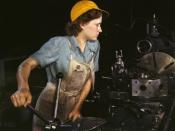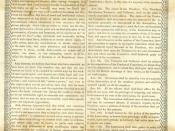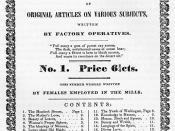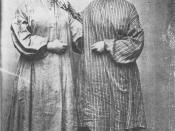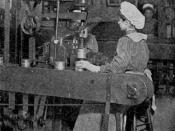The factory workers in Lowell raised much controversy in the eighteenth century when "modernization" was taking place in New England. Two concepts were widely held in regards to women at that time. First was the concept of "republican motherhood" which instructed women to stay home and raise children who would be virtuous assets to the republican government. Second, the concept of the "cult of true womanhood" called for women to be pious, pure, submissive, and domestic. The movement of girls to work in the Lowell factories challenged both these ideals as the girls were no longer living at home, which was considered their proper place to be as the world would strip them of their innate morality and piety; it also challenged the "domestic ideal" (p.141) for women as the factory girls were not dressing themselves as ladies. Thus, the fact that girls were moving away from home conflicted with the ideal that women should be moral and guiding homemakers, and the fact that they were not dressing like "ladies" conflicted with the ideal image of a woman.
The simple fact that women were leaving their homes to go and live in boarding houses conflicted with the ideals in the 18th century as women were seen as the chief means for creating a virtuous and pious domestic life. Women were thought to possess four innate qualities, which were submissiveness, purity, piety, and domesticity. Only in the home could a woman prosper morally and uphold her pious ways. Author Grace Greenwood wrote that a woman was like a "perpetual child" who is always "timid, doubtful, and clinginly dependent." (p.142) Thus, a woman who is not at home under the protection of a male would lose her virtue as she would stray from her pure and pious ways without direction, which would be tragic as women were the "spiritual uplifters of men." The evidence reveals this conflict as it shows how society feared that women would lose their morality as a result of being independent and outside of the home.
For example, source 1 contains the following quotation: "she has worked in a factory" is almost enough to damn to infamy the most worthy and virtuous girlâ¦.", which reveals the widely accepted belief that factory life would exterminate the innate virtue possessed by all "true women." Many of the boarding house's rules also reveal the attempts made at preserving morality and piety. Some of the rules are as follows: "no disorderly or improper conduct must be allowed in the houses. The doors must be closed at 10 o'clock in the evening; and no person admitted after that time unless a sufficient excuse can be given (p.146). "All persons are required to be constant in attendance on public worshipâ¦"(p.149) Source 2 also states that no person "addicted to intemperence" would be allowed to work for the company, and that the suspicion of and kind of "criminal conduct" or any association with persons who were immoral in such ways would lead to discharge of the suspected person. (p.147) Source 2 also states that "a girl suspected of immoralitiesâ¦. At once loses caste." (p.149) Thus, society reveals that women relocating at factories has stirred up the fear that women will lose their morality and become unbeneficial to in general. " To obtain this constant importation of female hands from the country, it is necessary to secure the moral protection of their character while they are resident in Lowell." (p.147) Also in conflict with the domestic idealogy for women in the 18th century was the manner in which they clothed themselves. (p.141). True women dressed in refined fabrics like silk, but in contrast, the Lowell girls wore crude dresses and aprons made out of cotton. Sources 16 and 17 depict the average factory worker as very plain and unfeminine. Source 16 shows the face and upper body of a girl wearing a plain black cotton dress with a plain white cotton collar. Her hair is pulled back with a part straight down the middle of her head-a very simple and "unfeminine" manner of styling hair. Likewise, source 17 shows two women standing side by side who are clothed in plain, straight cotton dresses with plain white cotton aprons. They are wearing plain, black, flat-footed shoes, and their hair is also parted straight back across the head and secured into a simple bun. The physical appearances of the factory girls challenged the ideal epitamy of what a true woman should look like as they looked plain and simple, and especially not very ladylike.(pp.165-166) In conclusion, the Lowell factory girls lives' conflicted with the American ideals for women in the 18th century as they were not reamaining at home where they could preserve their morality and virtue while being protected and watched over, and also as their physical appearnces were the direct opposite of that of a "true lady".
